Wednesday, November 07, 2007
New Orleans, in slow motion
If you’ve traveled west from Caracas towards the central Venezuelan cities of Maracay and Valencia you may have seen one of Venezuela’s largest fresh water lakes, the Lago de Valencia, or Valencia Lake. Then again, in spite of its size, you may not have seen it for reasons that will be apparent in a little while.
Here is a satellite photo of the lake:

From east to west it is about 21 miles in length. Its deepest point is about 120 feet and has a dozens of rivers and creeks that feed into it.
Its most important geographical feature is that it has no natural outlet. That is, water flows in from rivers but only leaves the lake via evaporation under natural conditions. This is because the lake sits in a wide saucer shaped depression surrounded on all sides by higher land. To the north, as can be seen in the photograph, the lake is bordered by the rapidly growing city of Maracay. To the west the large industrial city of Valencia also lies in the same basin. The final significant geographical feature is a large mountain range that lies to the north of Maracay and the lake and separate both from the Caribbean sea much as the Avila separates Caracas from the sea.
So why the interest in some stupid little lake in the middle of Venezuela? Simple, this lake has a very interesting story to tell about how Venezuela has been mismanaged and its environment neglected for decades.
As I mentioned even people have driven by the lake many times may have never seen it. In fact that was the case with me. I have gone right by it, probably within a half mile of it, dozens of times on the way between Caracas and Barquisimeto without ever catching even a glimpse of it. It would be fair to say the lake is well hidden.
That is not an accident, it is by design. The lake is in effect a dead lake. Not that there is no life in it at all – there is. But no human being who values their health goes anywhere near it. Not to swim in it, boat on it, or even to walk along its shore. And if you value your life you certainly wouldn’t drink from it. Its waters are toxic. Yet there is more to the unfolding disaster that is Valencia Lake than just that.
For centuries the lake was actually shrinking. The reason is simple. There were small towns and cities all around it, they needed water, they took the water from the lake faster than it flowed in, and the lake shrank. Unfortunately, as those towns and cities grew and developed industry they needed a place to dump the human and industrial waste and as you might guess they dumped it into either into streams feeding the lake or directly in the lake itself. By the 1960s and 1970s the lake became very contaminated and unusable as either a source of recreation or of potable water. Tragically Venezuelans through indifference to the environment and mismanagement destroyed yet another of their natural treasures.
If the story of the Lago de Valencia ended there it would be bad enough. But it doesn’t. Generally when humans abuse their natural surroundings nature finds a way to fight back. And right now the Lago de Valencia is certainly exacting revenge for what has been done to it.
Here is how.
As the lake became contaminated it could no longer serve as a source of drinking water for the communities around it. Further the cities of Maracay and Valencia were growing rapidly so that even the rivers feeding the lake couldn’t supply enough clean water (and they have their own contamination problems but more on that later). The only solution was to bring water to those cities from elsewhere.
Large pipelines were built starting in 1978 to bring water in from Cojedes state which is further to the south. Two of these pipelines have been built bring in 11,500 liters of water per second to the Valencia basin from the dammed reservoirs Pao-Cachinche and Pao-Las Balsas. This water system, known as the aquaducto regional del centro, now meets the clean water needs of the region.
Yet given the very delicate balance of all natural systems it is often the case that changes which resolve one problem create yet another. Sure enough, that happened in this case.
All the water being piped in to the Valencia basin has to go somewhere after it is used. And given that it is in a saucer like basin where everything drains down the lake all this water eventually winds up the lake. Given that this lake has no outlets it is easy to see that a huge new volume of water being brought in every second of every day will quickly exceed the amount of water that leaves the lake through evaporation and he lake level will rise.
It has done just that. It is now rising approximately one foot per year. As it rises it is quickly expanding and flooding the flat low lying land that surrounds it. Thus via the law of unintended consequences an attempt to supply clean water to a growing population has turned the Valencia Lake into a monster that now threatens to consume those very same urban areas.
For the people in the southern part of the city of Maracay the monster is already at the door. For a person seeing it for the first time what is unfolding in southern Maracay is surreal and stunning. Although I have no pictures that can truly do it just here are some that at least provide some inkling:


At very first glance the shimmering lake might seem normal and even somewhat attractive with the mountains in the background. But look closely and you’ll see signs of something amiss. Clearly visible are dead trees in the water. Those trees were only a few years ago on dry land – as the lake rose they became submerged and died. Also, in addition although they are hard to discern in these pictures you can also see telephone and utility polls. That is right, there used to be communities were the water is now. The remaining remnants are the occasional pole poking above the water.
Even more interesting than these lake scenes is the location from which these pictures were taken. I was actually standing on a 15 foot tall levee (yes, the same type of thing that was to protect New Orleans) that is holding back the water and keeping from flooding even more of the city.
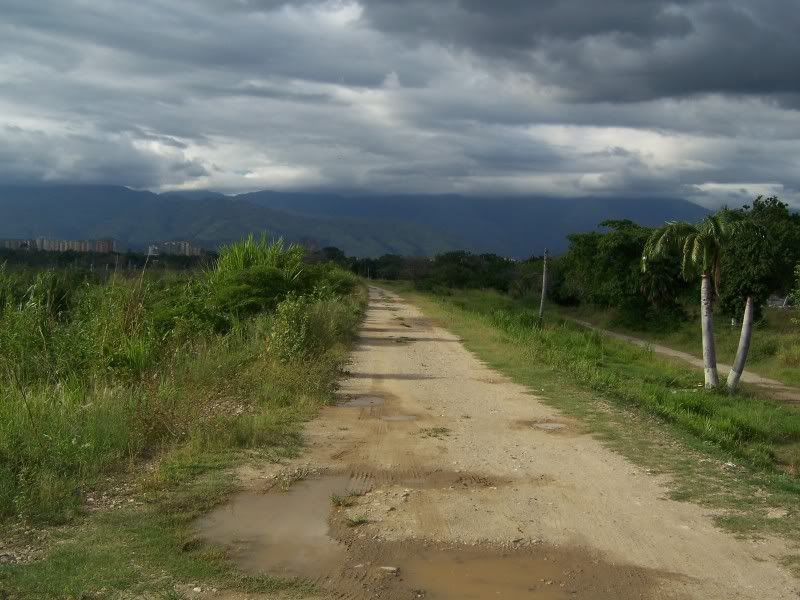
This is looking along the levee showing the road that runs along it. To the right would be the land being protected and to the left, out of view, is the lake. But earthen walls are not enough to keep the lake at bay. So they, just like New Orleans, having huge pumping stations to try to remove the water from behind the levee and put it back in the lake.

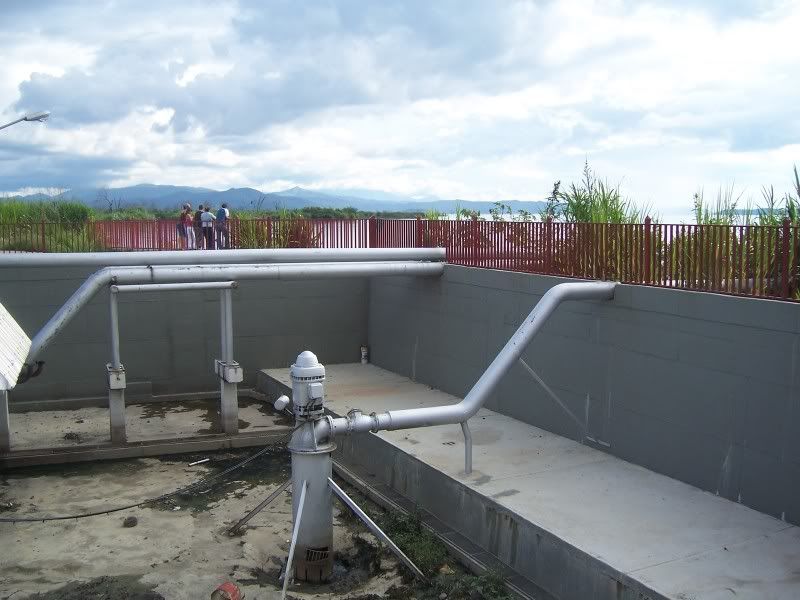
The people in the pictures are on top of the levee and the concrete foundation is at the level of the land behind the levee so from this you can get a sense of its size. These pumping stations have to run 24/7 removing water that seeps behind the levee, rain water that collects behind them, and rivers that used to outlet to the lake but now find this earthen wall blocking their way.
Oh and here is what the city looks like behind the levee:
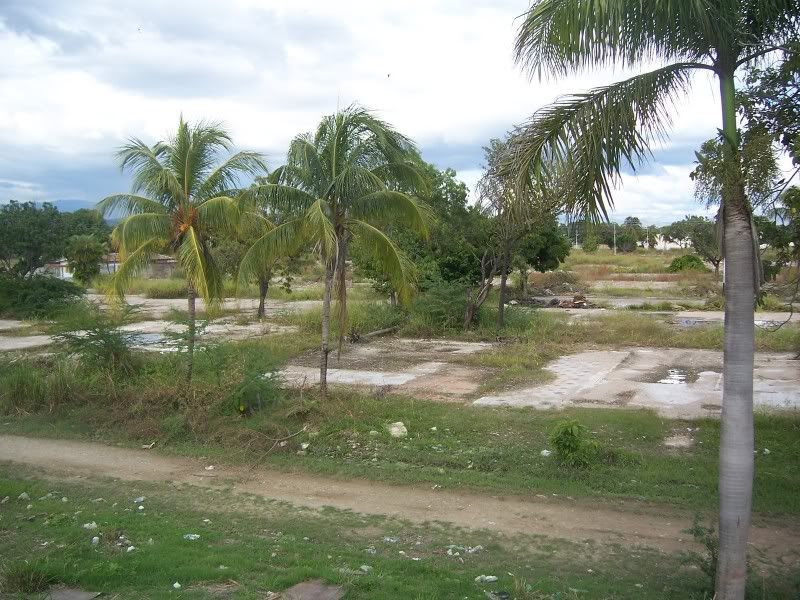
What, those are just vacant lots you say? Indeed they are. Surrounding the levee you see nothing but the former foundation of middle class homes that had to be demolished. The reason they were demolished is that even though the levee is offering some protection the water level has risen so high that water delivery and sewage systems no longer work. Without those systems working the area is uninhabitable.
This wasteland of destroyed communities is quite extensive – thousands of homes, stores and schools have already had to be destroyed so that you see acres and acres of this:
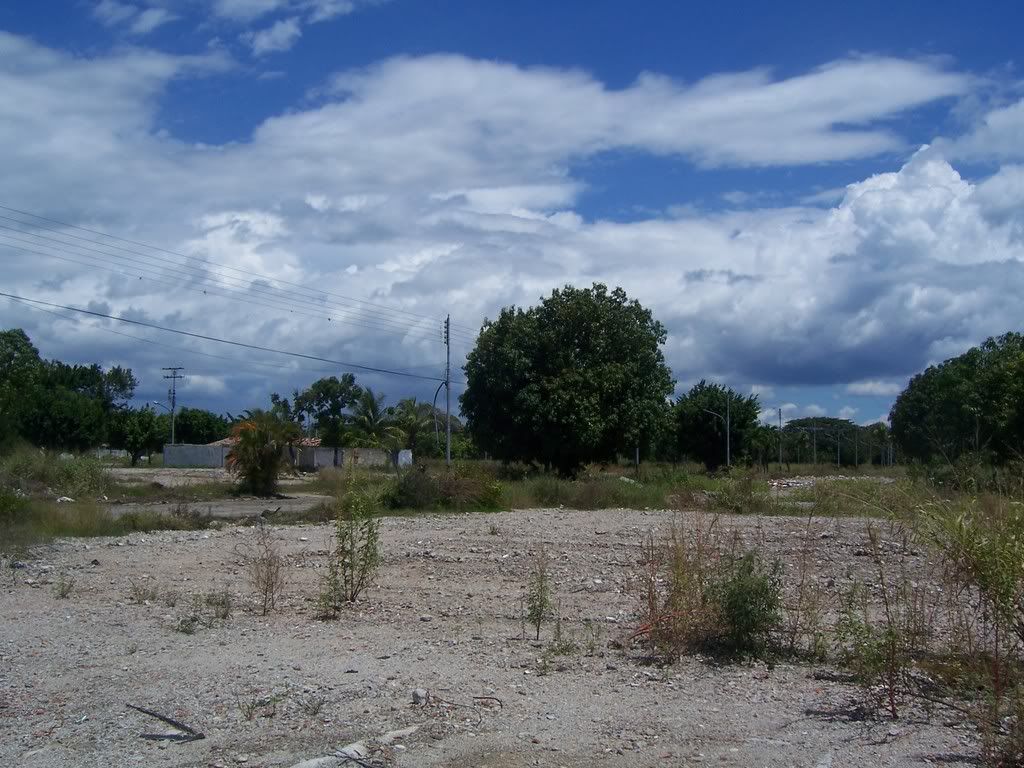
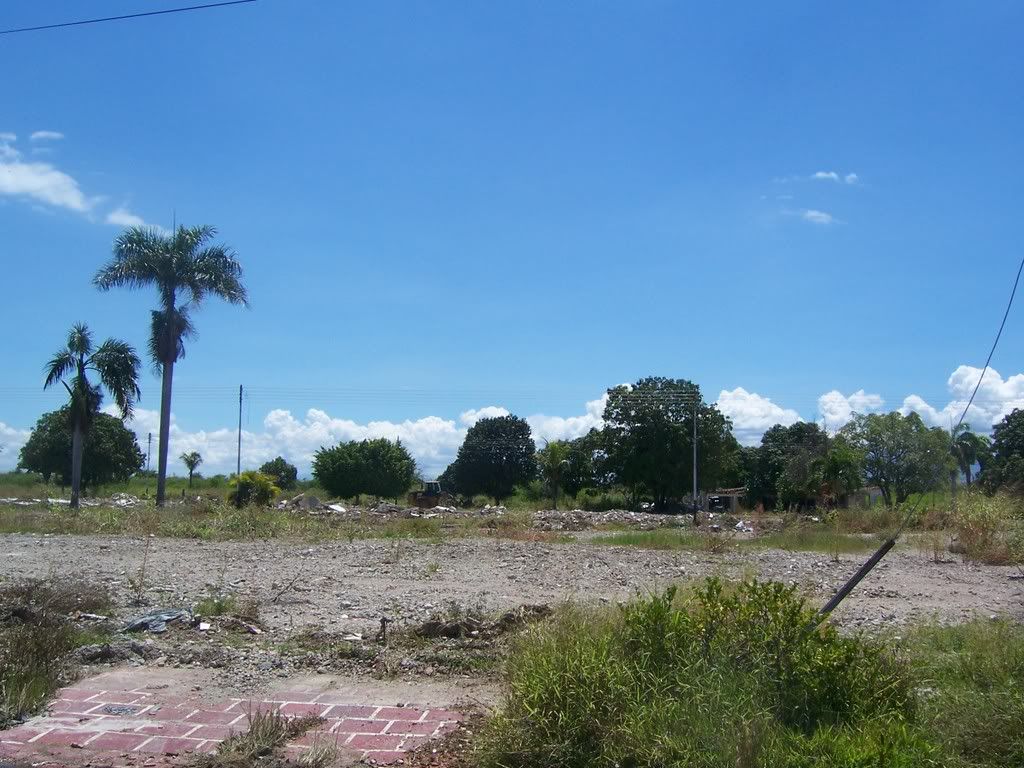
It is truly a pitiful and depressing site. But that is not the worst. The worst is that this devastation is growing each and every year. With the water level rising steadily each year more communities have to be abandoned by their residents and heavy equipment is brought in to level them. Each year approximately 500 more homes have be destroyed and while I was there I got to see heavy equipment in action:
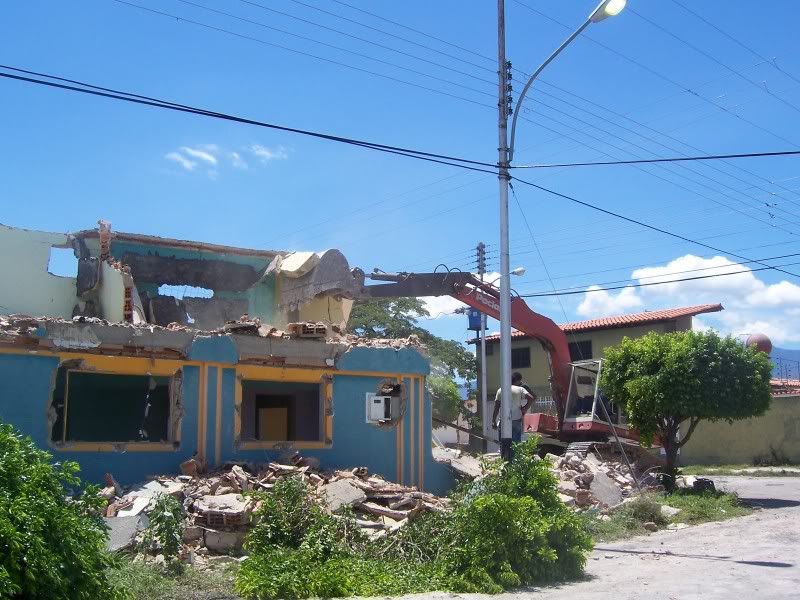
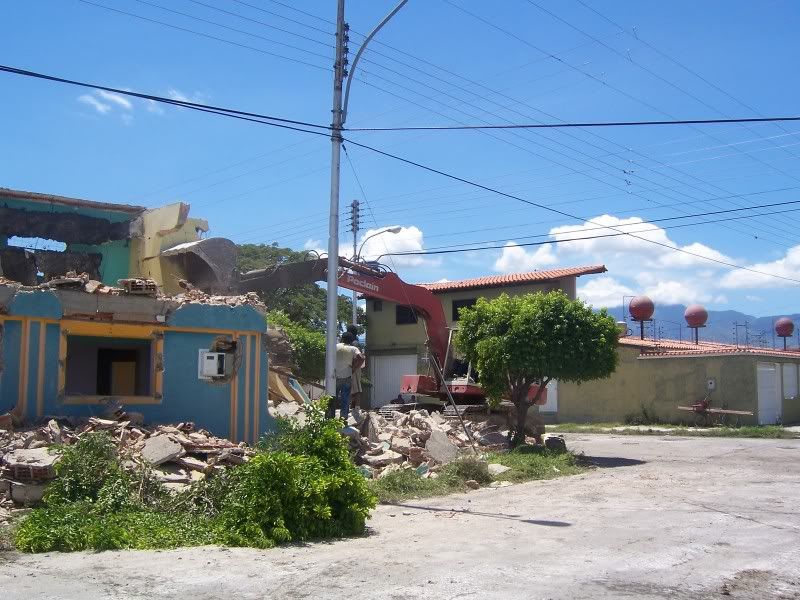
The destruction is incessant. It really is like what happened to New Orleans. The main difference is that here people are safely evacuated and there is no immediate loss of life. Yet unlike New Orleans in Maracay the destruction is anything but over – it keeps getting worse, day after day, week after week, month after month, and year after year.
In fact right around the corner from the above destruction the next victims – some rather nice middle class homes – awaited the same fate in the following days.
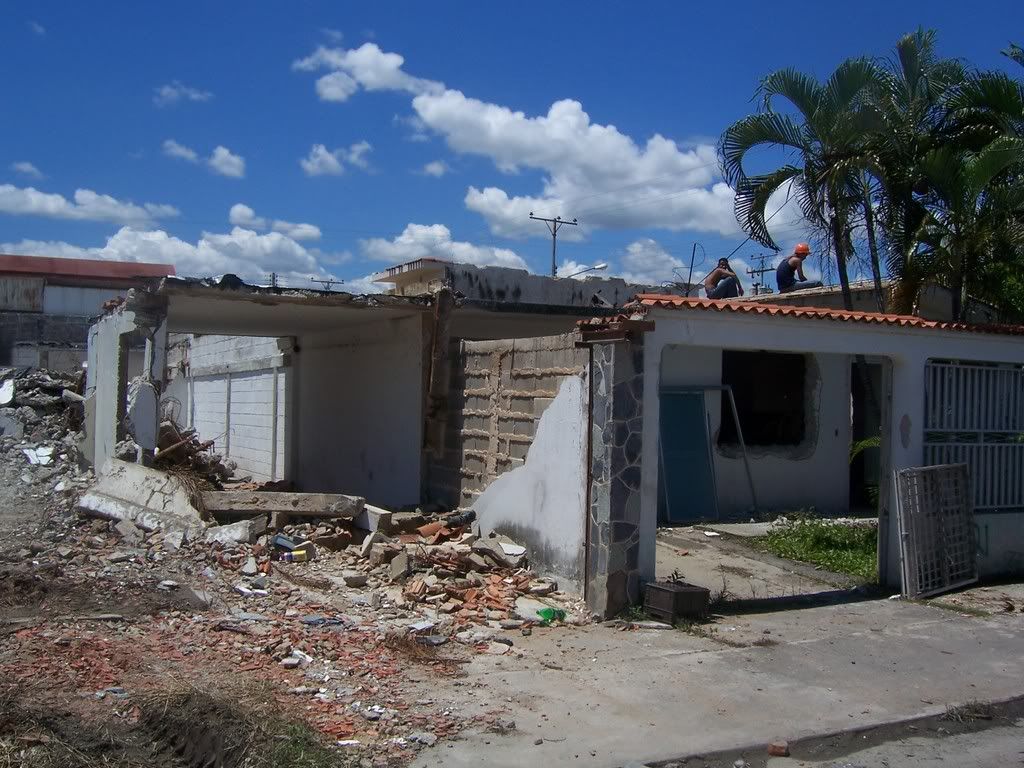
The owner of this home had just finished removing personally items and demolition was beginning. The owner spoke English and was eager to practice with a visitor so I got the full story. She had actually moved to this community from Caracas in 1976. People were encouraged to move there by the government to relieve congestion in Caracas and the people were happy to be moving into a comfortable middle class community.
In 1976 when she moved there the lake was not in their thoughts at all. It was 8 kilometers away. It never crossed their minds that a lake 8 kilometers away would one day destroy their homes and disrupt their lives.
Yet the irony doesn’t end there. Truth be told the woman wasn’t all that upset about what was happening. The reason is that all of these people who are losing their homes have been successfully able to sue the government and forced it to compensate them for their losses. Quite generously in fact. This woman as paid 350 million bolivares in compensation and she was moving back to live in a new apartment she bought in Caracas.
The reason people were able to make a claim against the government was because it was the government which had approved, even encouraged, them moving there in the first place. Not the Chavez government of course. It was the governments of Carlos Andres Perez, Jaime Lusinchi and Rafael Caldera that thought it was a good idea to move people there. The Chavez government just gets the pleasure of paying to clean up this whole mess.
The house right next door had already been knocked down:
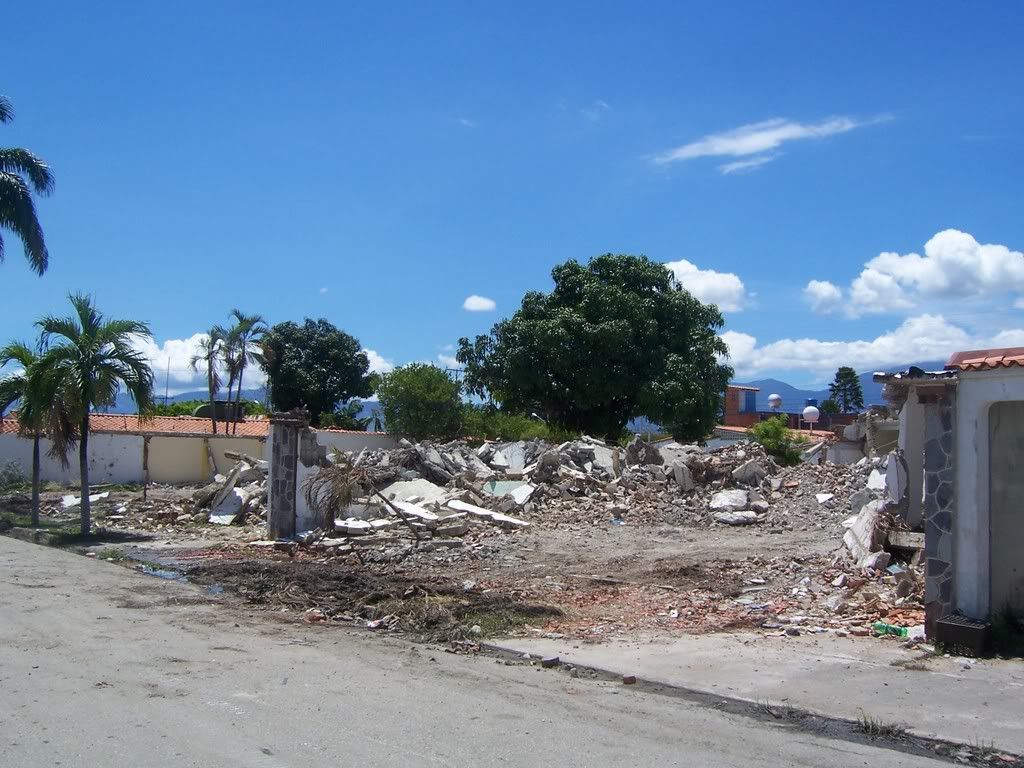
The house across the street was still being vacated and awaited its fate later in the week:
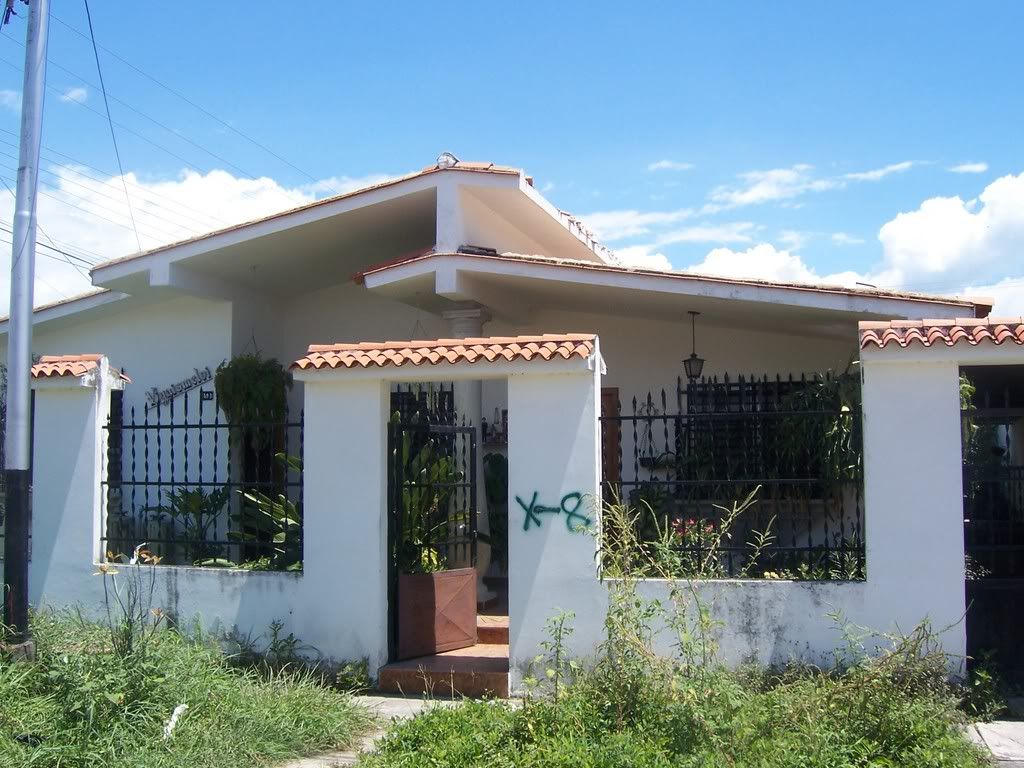
Note the “W-8” spray painted on the house (again, just like you know where). That tells the demolition crews that this house has been paid off by the government and is ready for demolition. You can drive by block after block where all the homes have these numbers spray painted on them making them ready to be turned into a pile of rubble just like this.
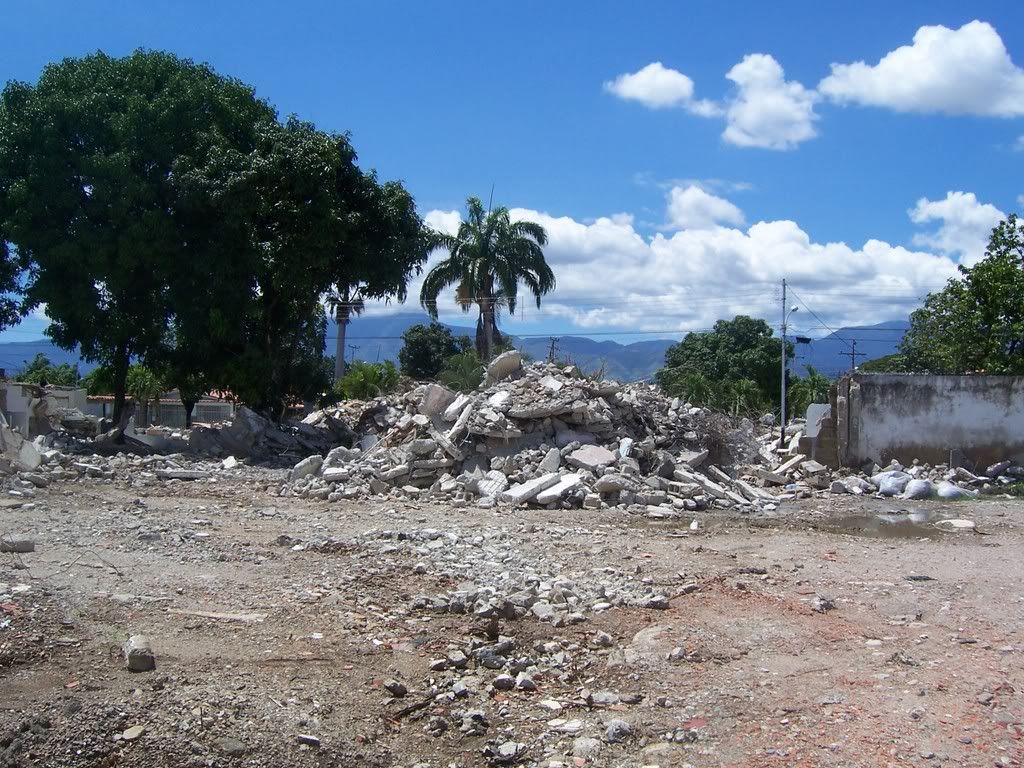
By the way, for some people this destruction actually can’t come soon enough:
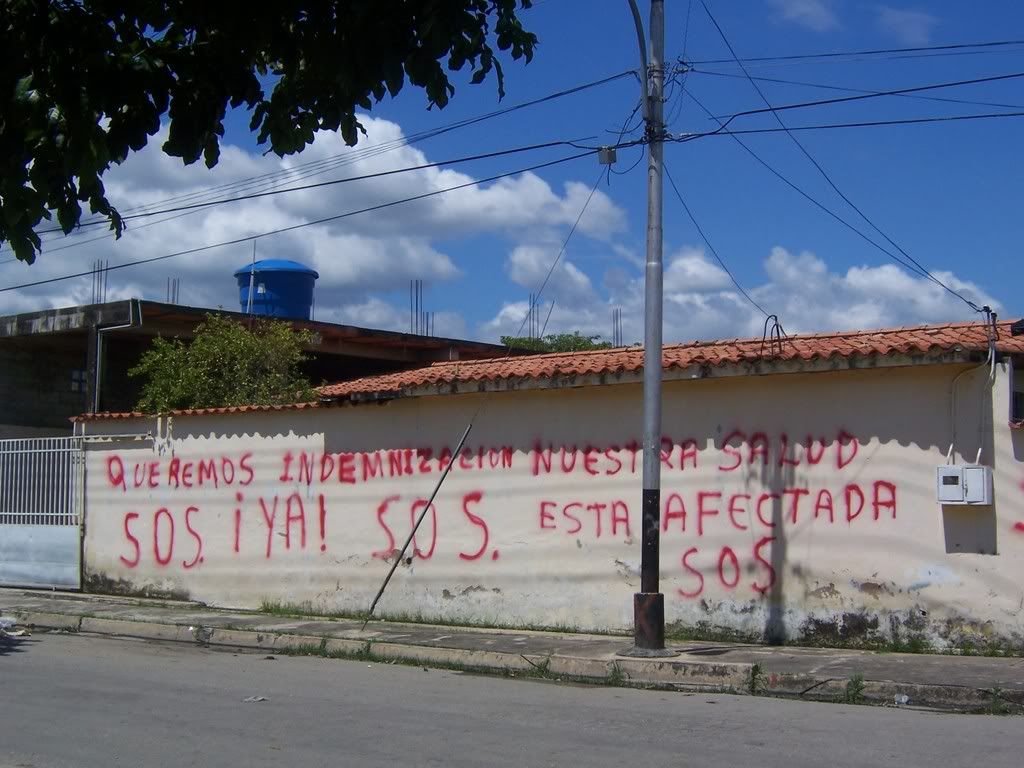
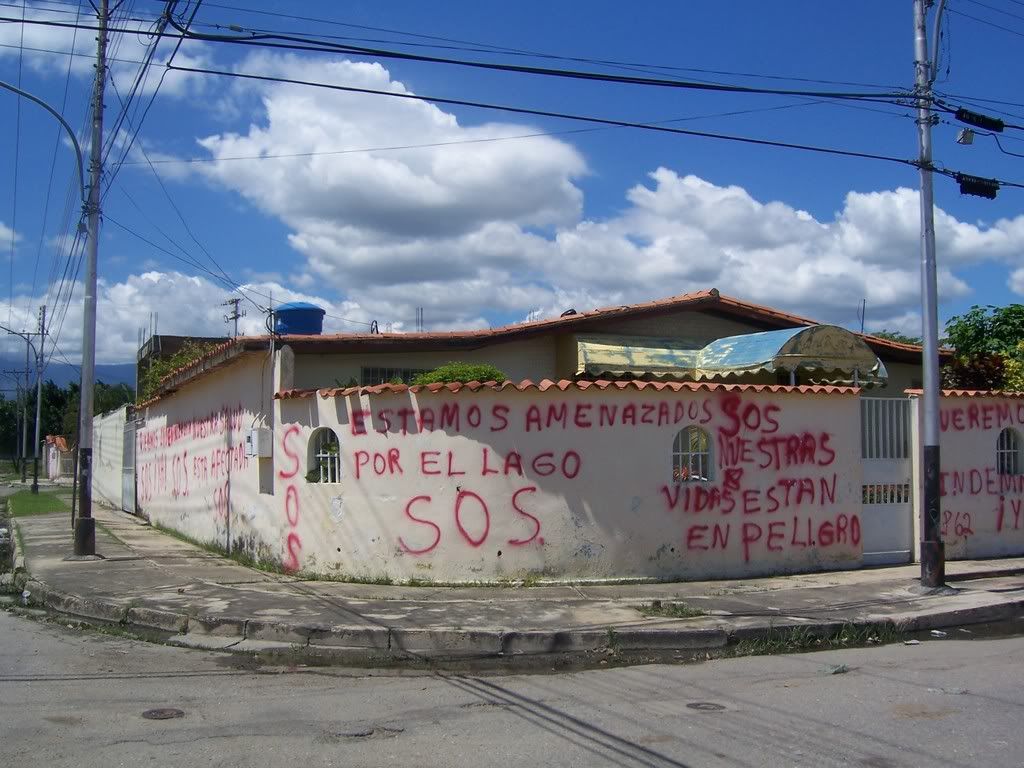
This house with “S.O.S.” painted all over for it complains that the lake is “making us sick” and demands compensation to move elsewhere. This house was actually not that far from where the homes were already being destroyed and was probably no more than a year away from being destroyed itself. This house right next to it (and you can see these are actually very nice homes) already has its spray painted number sealing its fate:
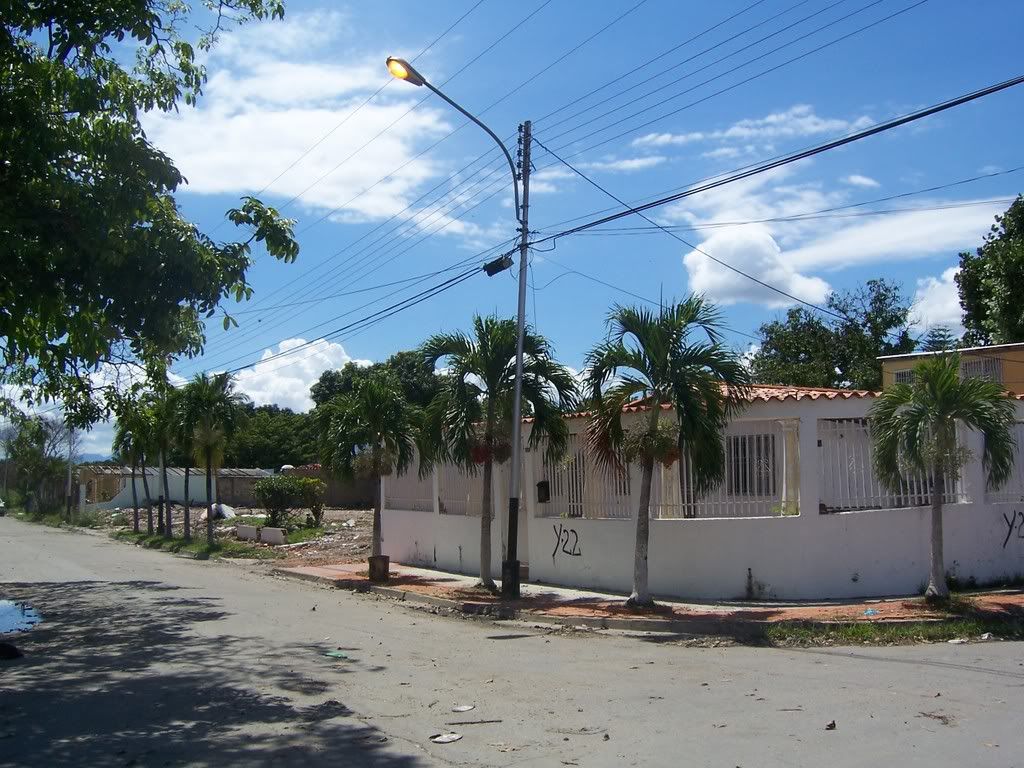
To get sense of proportion you should note this home was about 20 blocks away from the levee.
Driving around this scene of massive destruction you also see many partly flooded streets which show why they are in a hurry to evacuate these areas:
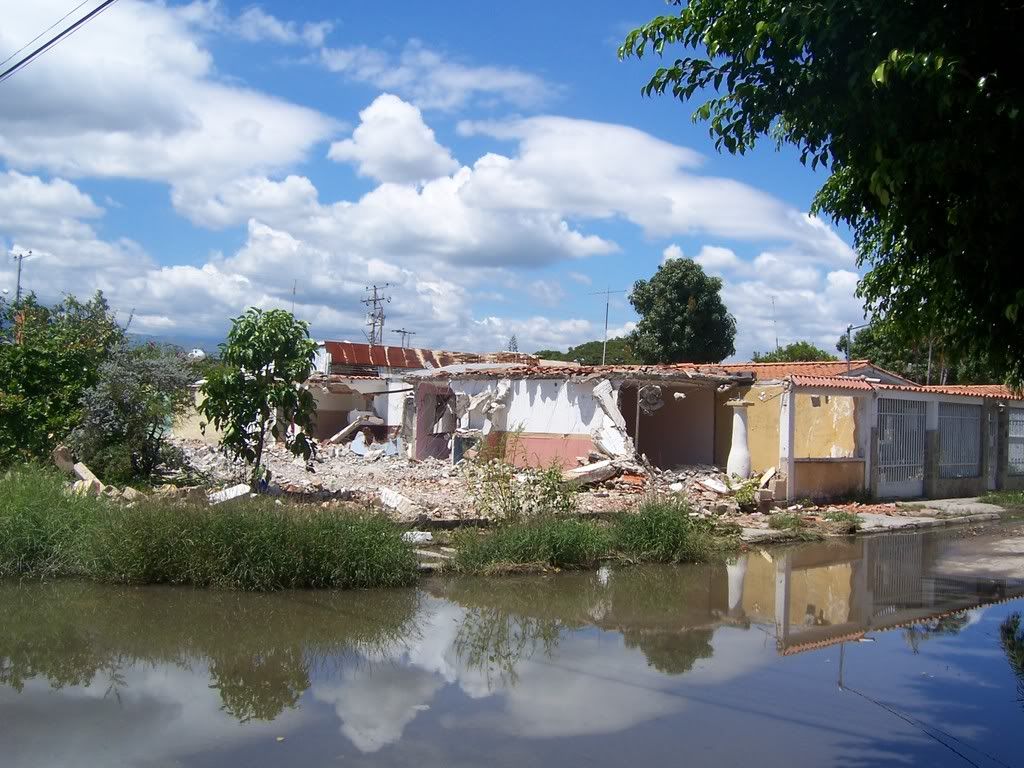
It needs to be kept in mind that this is but one section of the city. Later I visited other parts of Maracay along the lake and the exact same process was playing out there.
Slowly but surely a city of almost a million people is being destroyed by decades of poor planning and neglect.
What is being done about this? Can Maracay be saved? Yes it can and while there is no immediate solution at hand there are a couple proposals that could reverse this process.
One proposed solution is to pump water out of the lake to some other place. The problem is, because the lake is in a big depression you have to pump it a long distance to get it some place where it won’t simply run right back into the lake. If fact the closest place to pump it, and the one actually proposed, is over the mountains running north of Maracay along the coast. Of course that would still be quite a feat to do that – those mountains are every bit as big as the Avila mountain range in Caracas and pumping the water up and over them would not be easy.
But here is the really, really bad part of that plan and the reason we should all hope it is never implemented. The water would be pumped to the top of the mountains and simply dumped on the other side. This highly contaminated water would then run down the mountain streams through one of Venezuela’s most important national parks, the world famous and incredibly bio-diverse Parque Nacional Henri Pittier, and end up in the waters of some of its most pristine beaches. In other words, the ecological disaster that is Lake Valencia would be spread to an irreplaceable area of amazing and unique biological diversity.
All I have to say is that if that insane plan is given the green light then GreenPeace will need to get down their with some explosives and start blowing up those pumping stations and pipelines before they ever enter use.
The alternative to that cheap but devastating plan is quite ingenious, if possibly a good bit more expensive. It would involve constructing an outlet from the lake into an underground pipeline. It would be much like the drains on bathroom sinks that ensure they never overflow – it is a permanent outlet and as soon as the water reaches that level it flows into the drain (or pipeline) and does not rise any higher. This would completely stop the level of the lake from rising and it could be placed at any level that they desired the lake remain at permanently.
The water still has to go somewhere and that part of the solution is also ingenious. A tunnel to carry the water would be drilled underneath the mountains and would carry the excess lake water to the sea. Because the lake is more than 200 meters above sea level the tunnel would have a constant downward slope and no pumping would be necessary – it would be an entirely gravity operated drainage system.
It therefore has the huge advantage that once built it would cost almost nothing to operate. In fact its proponents thought that a concession to a private company to install and run a small electricity generating turbine might help generate revenue to partially offset what would obviously be an expensive construction.
Finally, the tunnel would extend out into the sea for two kilometers before discharging the water. The water currents have been studied and would from that point carry the contaminated water out to sea (lets hope they got that study right or you can kiss the beaches of Choroni goodbye).
This would seem to be both a very elegant and robust solution to the problem that Maracay confronts. But due to its high cost it is not known when this will be built, or even if it ever will. Unfortunately decades of neglect and even arrogance towards the environment are now exacting a very high price which will have to be paid for years or even decades.
Of course, even if this ingenious plan is implemented the problem will not be completely solved. Valencia Lake will still be an unusable toxic stew even if it is no longer growing (actually it will probably be an even more concentrated and hence more poisonous stew as the chemicals and sewage will be more concentrated). To solve that problem is no less daunting and undertaking as it would require that all the industry located around the lake dispose of their wastes properly instead of simply dumping them in the lake. Given that this is one of the most industrialized areas of Venezuela that is probably no small task. At this point the Environment Ministry has yet to even finish a full census of all the industrial establishments there and what kind of wastes they generate.
Also, the wastes from the two million people living around the lake would have to stop being dumped into it and its tributaries as raw sewage. Work is further along in this regard and I was able to see some of it.
Several sewage treatment plants have already been constructed. However, for them to be effective piping has to be installed to bring the sewage that is currently dumped straight into rivers to the treatment plants. That work is already under way with dozens of kilometers of piping having been installed. Here we can see some of what they are up against:
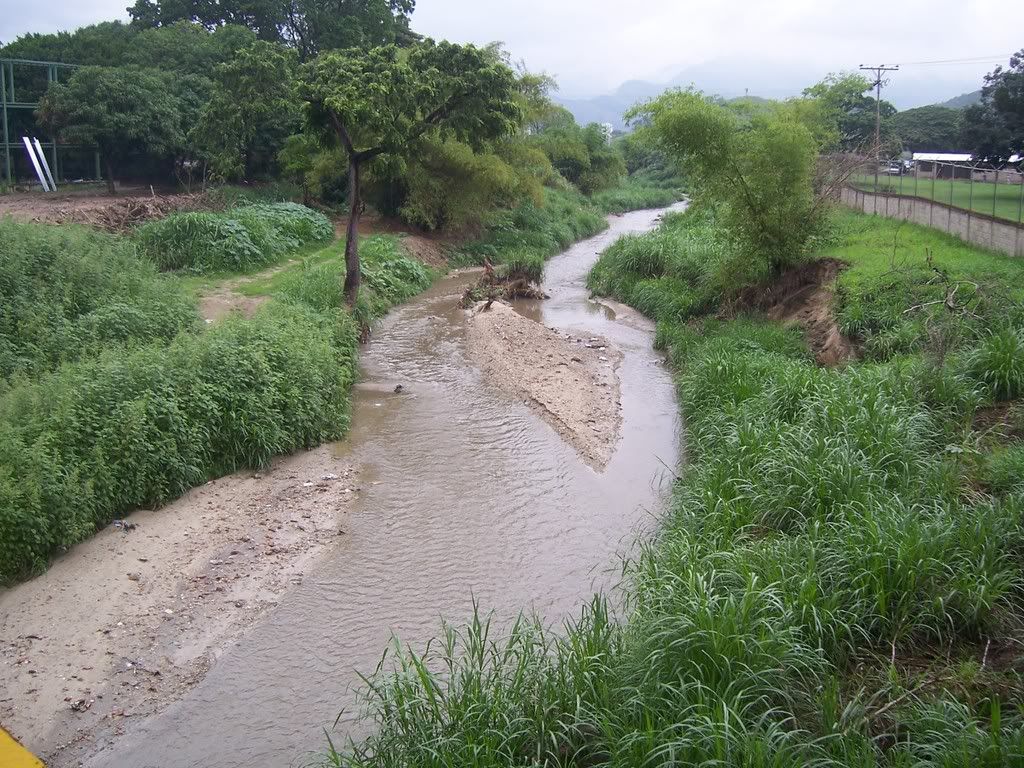
If you look carefully you can see a mostly submerged concrete tube to the left of the sandbar in the river. This pipe is discharging waste directly into the river which in turn empties a short distance later into the lake. Pipeline is being installed along the length of this and other rivers and connected to these existing pipes to intercept their waste before it enters the river and carry it to the treatment plant. Of course, this costs money (over a million dollars in fact) as this sign points out:
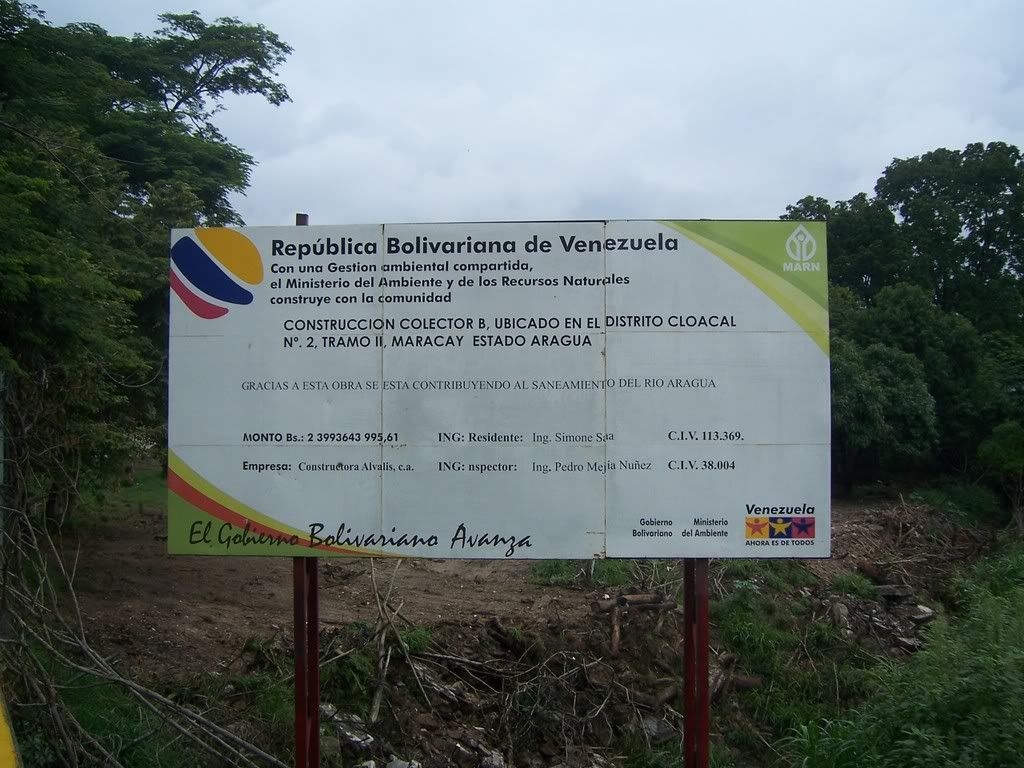
Through these measures it is hoped that the level of contamination can be reduced. But no one should expect to go swimming in this lake, much less drink its water, any time soon. It will remain contaminated for decades to come no matter what it done.
In fact, so extreme is the level of contamination that it even effects the plans for any recovered lands when the lake level is reduced. When the level of the lake is lowered many square kilometers of land will become available. However, the toxic chemicals from the water are now firmly embedded in the soil beneath the water making the land itself hazardous to human being and animals. The responsible thing they can think of to do with it is grow sugar cane on it and only use that sugar cane to make ethanol fuel. Absolutely nothing can be grown on that land that would ever enter the human food chain.
The situation with Lake Valencia is truly a disaster and unfortunately it has yet to fully run its course. This blogger has never been much involved with environmental issues but seeing this devastation first hand truly moved me. It showed in a very powerful way how when we abuse our natural surrounding the environment will in turn exact a price on us - sometimes with a vengeance. Humans simply can’t act with such disregard for their surroundings as Venezuelans clearly have for decades.
And there is no use finger pointing and trying to pass blame. Venezuela as a society is responsible for this mess (of which Lake Valencia is only ONE example) and they as a society will have to pay the price to fix this. If you walk through the southern part of the city of Maracay it will be made clear they can no longer just ignore it. That strategy of the past few decades will work no more.
|
Here is a satellite photo of the lake:

From east to west it is about 21 miles in length. Its deepest point is about 120 feet and has a dozens of rivers and creeks that feed into it.
Its most important geographical feature is that it has no natural outlet. That is, water flows in from rivers but only leaves the lake via evaporation under natural conditions. This is because the lake sits in a wide saucer shaped depression surrounded on all sides by higher land. To the north, as can be seen in the photograph, the lake is bordered by the rapidly growing city of Maracay. To the west the large industrial city of Valencia also lies in the same basin. The final significant geographical feature is a large mountain range that lies to the north of Maracay and the lake and separate both from the Caribbean sea much as the Avila separates Caracas from the sea.
So why the interest in some stupid little lake in the middle of Venezuela? Simple, this lake has a very interesting story to tell about how Venezuela has been mismanaged and its environment neglected for decades.
As I mentioned even people have driven by the lake many times may have never seen it. In fact that was the case with me. I have gone right by it, probably within a half mile of it, dozens of times on the way between Caracas and Barquisimeto without ever catching even a glimpse of it. It would be fair to say the lake is well hidden.
That is not an accident, it is by design. The lake is in effect a dead lake. Not that there is no life in it at all – there is. But no human being who values their health goes anywhere near it. Not to swim in it, boat on it, or even to walk along its shore. And if you value your life you certainly wouldn’t drink from it. Its waters are toxic. Yet there is more to the unfolding disaster that is Valencia Lake than just that.
For centuries the lake was actually shrinking. The reason is simple. There were small towns and cities all around it, they needed water, they took the water from the lake faster than it flowed in, and the lake shrank. Unfortunately, as those towns and cities grew and developed industry they needed a place to dump the human and industrial waste and as you might guess they dumped it into either into streams feeding the lake or directly in the lake itself. By the 1960s and 1970s the lake became very contaminated and unusable as either a source of recreation or of potable water. Tragically Venezuelans through indifference to the environment and mismanagement destroyed yet another of their natural treasures.
If the story of the Lago de Valencia ended there it would be bad enough. But it doesn’t. Generally when humans abuse their natural surroundings nature finds a way to fight back. And right now the Lago de Valencia is certainly exacting revenge for what has been done to it.
Here is how.
As the lake became contaminated it could no longer serve as a source of drinking water for the communities around it. Further the cities of Maracay and Valencia were growing rapidly so that even the rivers feeding the lake couldn’t supply enough clean water (and they have their own contamination problems but more on that later). The only solution was to bring water to those cities from elsewhere.
Large pipelines were built starting in 1978 to bring water in from Cojedes state which is further to the south. Two of these pipelines have been built bring in 11,500 liters of water per second to the Valencia basin from the dammed reservoirs Pao-Cachinche and Pao-Las Balsas. This water system, known as the aquaducto regional del centro, now meets the clean water needs of the region.
Yet given the very delicate balance of all natural systems it is often the case that changes which resolve one problem create yet another. Sure enough, that happened in this case.
All the water being piped in to the Valencia basin has to go somewhere after it is used. And given that it is in a saucer like basin where everything drains down the lake all this water eventually winds up the lake. Given that this lake has no outlets it is easy to see that a huge new volume of water being brought in every second of every day will quickly exceed the amount of water that leaves the lake through evaporation and he lake level will rise.
It has done just that. It is now rising approximately one foot per year. As it rises it is quickly expanding and flooding the flat low lying land that surrounds it. Thus via the law of unintended consequences an attempt to supply clean water to a growing population has turned the Valencia Lake into a monster that now threatens to consume those very same urban areas.
For the people in the southern part of the city of Maracay the monster is already at the door. For a person seeing it for the first time what is unfolding in southern Maracay is surreal and stunning. Although I have no pictures that can truly do it just here are some that at least provide some inkling:


At very first glance the shimmering lake might seem normal and even somewhat attractive with the mountains in the background. But look closely and you’ll see signs of something amiss. Clearly visible are dead trees in the water. Those trees were only a few years ago on dry land – as the lake rose they became submerged and died. Also, in addition although they are hard to discern in these pictures you can also see telephone and utility polls. That is right, there used to be communities were the water is now. The remaining remnants are the occasional pole poking above the water.
Even more interesting than these lake scenes is the location from which these pictures were taken. I was actually standing on a 15 foot tall levee (yes, the same type of thing that was to protect New Orleans) that is holding back the water and keeping from flooding even more of the city.

This is looking along the levee showing the road that runs along it. To the right would be the land being protected and to the left, out of view, is the lake. But earthen walls are not enough to keep the lake at bay. So they, just like New Orleans, having huge pumping stations to try to remove the water from behind the levee and put it back in the lake.


The people in the pictures are on top of the levee and the concrete foundation is at the level of the land behind the levee so from this you can get a sense of its size. These pumping stations have to run 24/7 removing water that seeps behind the levee, rain water that collects behind them, and rivers that used to outlet to the lake but now find this earthen wall blocking their way.
Oh and here is what the city looks like behind the levee:

What, those are just vacant lots you say? Indeed they are. Surrounding the levee you see nothing but the former foundation of middle class homes that had to be demolished. The reason they were demolished is that even though the levee is offering some protection the water level has risen so high that water delivery and sewage systems no longer work. Without those systems working the area is uninhabitable.
This wasteland of destroyed communities is quite extensive – thousands of homes, stores and schools have already had to be destroyed so that you see acres and acres of this:


It is truly a pitiful and depressing site. But that is not the worst. The worst is that this devastation is growing each and every year. With the water level rising steadily each year more communities have to be abandoned by their residents and heavy equipment is brought in to level them. Each year approximately 500 more homes have be destroyed and while I was there I got to see heavy equipment in action:


The destruction is incessant. It really is like what happened to New Orleans. The main difference is that here people are safely evacuated and there is no immediate loss of life. Yet unlike New Orleans in Maracay the destruction is anything but over – it keeps getting worse, day after day, week after week, month after month, and year after year.
In fact right around the corner from the above destruction the next victims – some rather nice middle class homes – awaited the same fate in the following days.

The owner of this home had just finished removing personally items and demolition was beginning. The owner spoke English and was eager to practice with a visitor so I got the full story. She had actually moved to this community from Caracas in 1976. People were encouraged to move there by the government to relieve congestion in Caracas and the people were happy to be moving into a comfortable middle class community.
In 1976 when she moved there the lake was not in their thoughts at all. It was 8 kilometers away. It never crossed their minds that a lake 8 kilometers away would one day destroy their homes and disrupt their lives.
Yet the irony doesn’t end there. Truth be told the woman wasn’t all that upset about what was happening. The reason is that all of these people who are losing their homes have been successfully able to sue the government and forced it to compensate them for their losses. Quite generously in fact. This woman as paid 350 million bolivares in compensation and she was moving back to live in a new apartment she bought in Caracas.
The reason people were able to make a claim against the government was because it was the government which had approved, even encouraged, them moving there in the first place. Not the Chavez government of course. It was the governments of Carlos Andres Perez, Jaime Lusinchi and Rafael Caldera that thought it was a good idea to move people there. The Chavez government just gets the pleasure of paying to clean up this whole mess.
The house right next door had already been knocked down:

The house across the street was still being vacated and awaited its fate later in the week:

Note the “W-8” spray painted on the house (again, just like you know where). That tells the demolition crews that this house has been paid off by the government and is ready for demolition. You can drive by block after block where all the homes have these numbers spray painted on them making them ready to be turned into a pile of rubble just like this.

By the way, for some people this destruction actually can’t come soon enough:


This house with “S.O.S.” painted all over for it complains that the lake is “making us sick” and demands compensation to move elsewhere. This house was actually not that far from where the homes were already being destroyed and was probably no more than a year away from being destroyed itself. This house right next to it (and you can see these are actually very nice homes) already has its spray painted number sealing its fate:

To get sense of proportion you should note this home was about 20 blocks away from the levee.
Driving around this scene of massive destruction you also see many partly flooded streets which show why they are in a hurry to evacuate these areas:

It needs to be kept in mind that this is but one section of the city. Later I visited other parts of Maracay along the lake and the exact same process was playing out there.
Slowly but surely a city of almost a million people is being destroyed by decades of poor planning and neglect.
What is being done about this? Can Maracay be saved? Yes it can and while there is no immediate solution at hand there are a couple proposals that could reverse this process.
One proposed solution is to pump water out of the lake to some other place. The problem is, because the lake is in a big depression you have to pump it a long distance to get it some place where it won’t simply run right back into the lake. If fact the closest place to pump it, and the one actually proposed, is over the mountains running north of Maracay along the coast. Of course that would still be quite a feat to do that – those mountains are every bit as big as the Avila mountain range in Caracas and pumping the water up and over them would not be easy.
But here is the really, really bad part of that plan and the reason we should all hope it is never implemented. The water would be pumped to the top of the mountains and simply dumped on the other side. This highly contaminated water would then run down the mountain streams through one of Venezuela’s most important national parks, the world famous and incredibly bio-diverse Parque Nacional Henri Pittier, and end up in the waters of some of its most pristine beaches. In other words, the ecological disaster that is Lake Valencia would be spread to an irreplaceable area of amazing and unique biological diversity.
All I have to say is that if that insane plan is given the green light then GreenPeace will need to get down their with some explosives and start blowing up those pumping stations and pipelines before they ever enter use.
The alternative to that cheap but devastating plan is quite ingenious, if possibly a good bit more expensive. It would involve constructing an outlet from the lake into an underground pipeline. It would be much like the drains on bathroom sinks that ensure they never overflow – it is a permanent outlet and as soon as the water reaches that level it flows into the drain (or pipeline) and does not rise any higher. This would completely stop the level of the lake from rising and it could be placed at any level that they desired the lake remain at permanently.
The water still has to go somewhere and that part of the solution is also ingenious. A tunnel to carry the water would be drilled underneath the mountains and would carry the excess lake water to the sea. Because the lake is more than 200 meters above sea level the tunnel would have a constant downward slope and no pumping would be necessary – it would be an entirely gravity operated drainage system.
It therefore has the huge advantage that once built it would cost almost nothing to operate. In fact its proponents thought that a concession to a private company to install and run a small electricity generating turbine might help generate revenue to partially offset what would obviously be an expensive construction.
Finally, the tunnel would extend out into the sea for two kilometers before discharging the water. The water currents have been studied and would from that point carry the contaminated water out to sea (lets hope they got that study right or you can kiss the beaches of Choroni goodbye).
This would seem to be both a very elegant and robust solution to the problem that Maracay confronts. But due to its high cost it is not known when this will be built, or even if it ever will. Unfortunately decades of neglect and even arrogance towards the environment are now exacting a very high price which will have to be paid for years or even decades.
Of course, even if this ingenious plan is implemented the problem will not be completely solved. Valencia Lake will still be an unusable toxic stew even if it is no longer growing (actually it will probably be an even more concentrated and hence more poisonous stew as the chemicals and sewage will be more concentrated). To solve that problem is no less daunting and undertaking as it would require that all the industry located around the lake dispose of their wastes properly instead of simply dumping them in the lake. Given that this is one of the most industrialized areas of Venezuela that is probably no small task. At this point the Environment Ministry has yet to even finish a full census of all the industrial establishments there and what kind of wastes they generate.
Also, the wastes from the two million people living around the lake would have to stop being dumped into it and its tributaries as raw sewage. Work is further along in this regard and I was able to see some of it.
Several sewage treatment plants have already been constructed. However, for them to be effective piping has to be installed to bring the sewage that is currently dumped straight into rivers to the treatment plants. That work is already under way with dozens of kilometers of piping having been installed. Here we can see some of what they are up against:

If you look carefully you can see a mostly submerged concrete tube to the left of the sandbar in the river. This pipe is discharging waste directly into the river which in turn empties a short distance later into the lake. Pipeline is being installed along the length of this and other rivers and connected to these existing pipes to intercept their waste before it enters the river and carry it to the treatment plant. Of course, this costs money (over a million dollars in fact) as this sign points out:

Through these measures it is hoped that the level of contamination can be reduced. But no one should expect to go swimming in this lake, much less drink its water, any time soon. It will remain contaminated for decades to come no matter what it done.
In fact, so extreme is the level of contamination that it even effects the plans for any recovered lands when the lake level is reduced. When the level of the lake is lowered many square kilometers of land will become available. However, the toxic chemicals from the water are now firmly embedded in the soil beneath the water making the land itself hazardous to human being and animals. The responsible thing they can think of to do with it is grow sugar cane on it and only use that sugar cane to make ethanol fuel. Absolutely nothing can be grown on that land that would ever enter the human food chain.
The situation with Lake Valencia is truly a disaster and unfortunately it has yet to fully run its course. This blogger has never been much involved with environmental issues but seeing this devastation first hand truly moved me. It showed in a very powerful way how when we abuse our natural surrounding the environment will in turn exact a price on us - sometimes with a vengeance. Humans simply can’t act with such disregard for their surroundings as Venezuelans clearly have for decades.
And there is no use finger pointing and trying to pass blame. Venezuela as a society is responsible for this mess (of which Lake Valencia is only ONE example) and they as a society will have to pay the price to fix this. If you walk through the southern part of the city of Maracay it will be made clear they can no longer just ignore it. That strategy of the past few decades will work no more.
|
